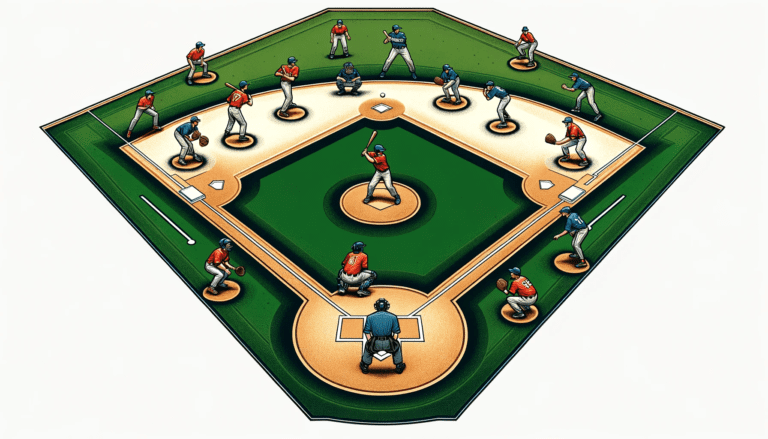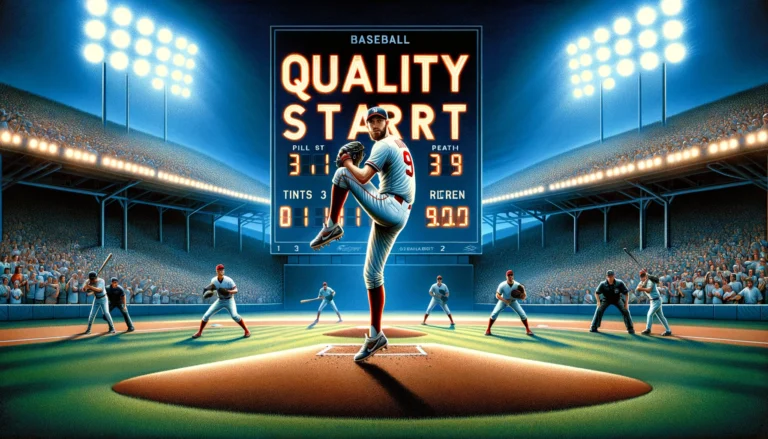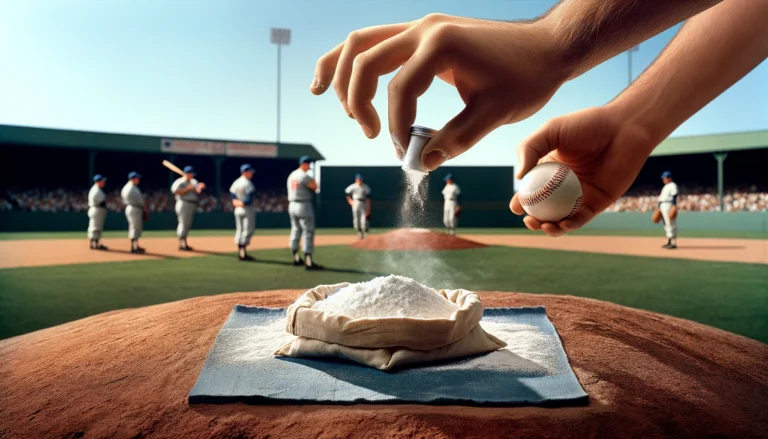What is an Assist in Baseball?
An assist in baseball is a defensive play where a fielder helps get batted ball by an offensive player out. It’s awarded to a fielder who touches the ball before throwing it to the player who records the putout.
For example, if the shortstop fields a ground ball and throws to the first baseman to get the batter out, both players get credited – the shortstop gets the ground ball outs an assist, and the first baseman gets the putout.
Let’s look at how an assist impacts the dynamics of baseball and why it’s a vital part of the sport’s scoring system.
Key Takeaways
- Assists are a vital component of baseball defense, reflecting a player’s ability to contribute to outs beyond just catching or pitching.
- The strategic implementation of assists, especially in double plays and run prevention, can significantly influence the outcome of a game.
- Historical and statistical analyses of assists offer insights into team success and individual defensive prowess, highlighting their importance in the sport.
- Player development in the realm of assists focuses on refining techniques and recognizing assist potential, which is crucial for scouting and career progression.
- Advancements in baseball analytics continue to evolve the measurement and valuation of assists, integrating them into more comprehensive player evaluations.
The Anatomy of an Assist in Baseball

Defining the Assist: More Than Just a Throw
In baseball, an assist is credited to a player who makes a play that directly contributes to a putout.
While often perceived as merely a throw, the assist encompasses a broader range of actions on the field.
For instance:
- A player who fields a ground ball and throws it to another player to get the runner out at first base.
- An outfielder who relays the ball to an infielder, leading to a tag out at home plate.
- A quick flip from a second baseman to the shortstop during a double play.
Each of these scenarios involves skillful coordination and execution, highlighting the assistant’s integral role in the defensive strategy.
An assist in baseball goes to any defensive player who fields or touches the live ball—hit by the batter—before the recording of a putout.
This might happen as part of a routine play or a spectacular dive and throw, demonstrating the player’s agility and awareness.
The assist is a testament to a player’s defensive acumen, with one assist marking their contribution to the team’s overall defensive prowess.
The Mechanics of Making an Assist
The mechanics of making an assist in baseball are a blend of physical skill and situational awareness.
An assist is credited to a fielding player who significantly contributes to a putout, usually by throwing the ball to another player.
The process typically involves several key steps:
- Fielding the ball cleanly and quickly.
- Making a rapid and accurate assessment of the base runners’ positions.
- Executing a strong and precise throw to the intended teammate.
Each position on the field has its own nuances when it comes to assists. Infielders, for example, must be adept at quick transfers from glove to hand, while outfielders need to focus on power and accuracy over longer distances.
The ability to make an assist can hinge on a player’s footwork, arm strength, and mental quickness.
Understanding the glossary of baseball terms can also be crucial, as clear communication between players often dictates the success of an assist.
Positional Breakdown: Who Gets the Most Assists?
In the realm of baseball, certain positions are more likely to rack up assists due to their roles and responsibilities on the field.
Shortstops and second basemen often lead the tally in assists, given their central positions and involvement in fielding ground balls and turning double plays.
Following closely are third basemen, who also have ample opportunities for assists, especially on bunts and grounders down the line.
Pitchers and catchers typically accumulate fewer assists, but their contributions are critical in specific situations like pickoffs and caught stealing attempts.
- Shortstops
- Second Basemen
- Third Basemen
- Pitchers
- Catchers
The statistical analysis suggests that the most important baseball positions based on performance metrics are starting pitcher, center fielder, and shortstop.
This insight aligns with the assist counts, underscoring the strategic significance of these roles in the defensive lineup.
Read Also: What is OPS in Baseball
Strategic Importance of Assists in Game Play
Assists in Double Plays: A Tactical Analysis
In the dynamic interplay of baseball, the double play stands out as a game-changer, often swinging momentum and shutting down potential rallies.
The assist is a critical component in executing a successful double play, requiring precise timing and coordination between fielders.
- The initial fielder must field the ball cleanly and make a quick, accurate throw to the pivot man.
- The pivot man, usually the second baseman or shortstop, must adeptly receive the throw, touch the base for the first out, and then relay the ball to first base with speed and accuracy.
- The first baseman’s role is to complete the play by catching the final throw, often requiring a stretch or scoop to secure the out.
This sequence underscores the importance of assists not just in individual statistics, but in their contribution to a team’s defensive strength.
The ability to turn two can deflate an opponent’s offense and is a testament to a team’s tactical acumen and infield synergy.
How Assists Contribute to Run Prevention
In the intricate dance of baseball defense, assists are pivotal in halting the offensive charge.
These crucial plays often go unnoticed in the shadow of flashier statistics, but their impact on run prevention is undeniable.
An assist occurs when a fielder contributes to an out by making a throw to another player, the batter runner who then records the out.
This can happen in various scenarios:
- A shortstop fields a ground ball and throws to first base for the out.
- An outfielder catches a fly ball and throws to a base to prevent a runner from advancing.
- A third baseman stops a hard-hit ball down the line and makes a long throw across the diamond.
Each assist removes the potential for runners to advance and score, tightening the defense’s grip on the game’s tempo.
By cutting down runners who are attempting to take extra bases, assists serve as a deterrent, making baserunners think twice before an extra base or taking risks.
Moreover, assists are integral to double plays, which can shift momentum and end scoring threats with swift efficiency.
The strategic placement of fielders and their ability to execute assists can therefore be a linchpin in a team’s defensive strategy, directly contributing to the suppression of runs and enhancing the defensive team control side’s chances of victory.
The Role of Assists in Shifting Defensive Strategies
In the dynamic world of baseball, defensive strategies are constantly evolving and assists play a crucial role in this evolution.
Assists are not just reactive plays; they shape the strategic positioning and movements of fielders.
For instance, a team may shift their infielders towards one side of the field when a pull-heavy batter is at the plate, anticipating the need for quick assists to secure outs.
- The anticipation of assists affects the infield and outfield alignments, with players positioning themselves to cover more ground and create opportunities for assists.
- Communication and coordination among players are vital, as assists often involve multiple fielders and can be the difference between a successful double play and a missed opportunity.
- The ability to execute assists can dictate the aggressiveness of a defensive strategy, allowing teams to take calculated risks in their positioning.
As analytics continue to influence the game, the strategic deployment of players for optimal assist opportunities is becoming more nuanced.
Teams that master the art of assists can gain a significant edge in controlling the game’s tempo and limiting the offensive threats posed by their opponents.
Read Also: What is WHIP in Baseball
Statistical Insights Assists

Assist Leaders: A Historical Perspective
Throughout the annals of baseball, the leaderboard for assists has been a testament to the defensive prowess of infielders.
Historically, shortstops and second basemen dominate the assist columns, reflecting the high volume of ground balls they field.
Notable figures in the history of outfield assists include legends like Ozzie Smith and Cal Ripken Jr., whose quick reflexes and strong arms set the standard for infield defense.
The significance of assists can also be seen in the context of baseball’s evolving strategies. As the game has shifted, with the rise of analytics and changes in hitting approaches, the types of plays and the frequency with which certain positions record assists have also changed.
This evolution underscores the adaptability and skill development required by infielders to stay atop the assist tables.
For those interested in delving deeper into the historical data on assists, Baseball-Reference.com stands as a comprehensive source.
It offers a treasure trove of information, from player stats to league-wide trends, allowing fans and analysts alike to track the progression of assist leaders over the decades.
Correlation Between Assists and Team Success
The relationship between assists and team success is not merely coincidental but a reflection of a team’s defensive strength.
Assists are often indicative of a team’s ability to efficiently convert batted balls into outs, which is a critical component of preventing runs.
Teams that excel in this area tend to have better overall defensive strategies, leading to more wins.
- Effective communication and coordination among fielders.
- Strategic positioning to increase the likelihood of assist opportunities.
- Quick and accurate throws to execute plays.
These elements are not only fundamental in the execution of assists but also in the broader context of a team’s defensive playbook.
The strategic management of a team’s defense, including the deployment of pitchers and fielders, can significantly influence the number of assists recorded throwing the ball.
For instance, a team may choose to intentionally walk a strong hitter to set up a potential double play, thereby increasing the chance for assists.
This tactic underscores the nuanced decision-making that can impact a team’s assist statistics and, by extension, their success in the league.
Assists as a Predictor of Defensive Prowess
The ability to consistently deliver assists is a strong indicator of a player’s defensive capabilities.
Assists are not just about fielding the ball, but also about making accurate and timely throws.
This skill set is crucial for infielders, where reaction time and throw precision can make the difference between an out and a safe call.
When evaluating a player’s defensive prowess, assists can provide a more nuanced understanding than traditional fielding statistics.
For instance:
- A high number of assists suggests good positioning and quick decision-making.
- Assists can also reflect a player’s range, as they often involve fielding balls that are harder to reach.
- The ability to turn double plays, which is a critical defensive maneuver, is partially quantified by assists.
However, assists should be considered in context. For example, Derek Jeter’s defensive performance has been a subject of debate.
While traditional metrics might undervalue his contributions, more nuanced analyses, such as run value calculations, offer a different perspective, indicating a positive defensive impact.
This highlights the importance of looking beyond raw assist totals to understand a player’s true defensive worth.
See Also: What is RBI in Baseball
Player Development and the Art of Assisting

Training Techniques for Improving Assist Skills
Mastering the art of the assist in baseball requires a multifaceted approach to training.
Developing quick reflexes and a strong, accurate arm are fundamental to a player’s ability to execute assists effectively.
Coaches and players alike focus on several key areas to enhance these skills:
- Drill repetition: Consistent practice of fielding drills can improve a player’s reaction time and precision when making plays.
- Strength training: A tailored strength and conditioning program helps build the arm strength necessary for powerful throws.
- Footwork exercises: Agile footwork is crucial for positioning the body optimally to make a throw.
- Mental simulations: Visualizing various game scenarios can prepare players for making split-second decisions on the field.
In addition to physical training, studying game footage plays a pivotal role in understanding the dynamics of assist opportunities.
By analyzing successful assists, players can identify patterns and develop a sense of anticipation, which is key to being in the right place at the right time.
Collaboration with teammates during practice sessions also allows for the refinement of communication and coordination, essential components for turning potential assists into outs.
The Evolution of Assisting Abilities in Players’ Careers
As players progress through their careers, their ability to execute assists often reflects their adaptation to the game’s increasing demands.
The development of assist skills is a testament to a player’s growth and refinement in the field.
Early in their careers, players may rely more on raw talent and physical prowess. However, as they gain experience, they learn to anticipate plays, refine their techniques, and make smarter decisions.
The trajectory of a player’s assist capabilities can be broken down into several stages:
- Acquisition of fundamental skills during the rookie years, focusing on the basics of fielding and throwing.
- Enhancement of situational awareness as they encounter a variety of game scenarios.
- Optimization of physical conditioning to maintain quick reflexes and strong throws.
- Strategic collaboration with teammates to execute complex plays.
This evolution is often influenced by the changing dynamics of Major League Baseball, where the unprecedented wave of innovations in coaching and training methods has raised the bar for defensive play.
More and more teams are investing in their on-field staff, recognizing the importance of specialized coaching roles that can directly impact a player’s ability to assist effectively.
Scouting for Assist Potential in Prospects
Identifying prospects with high assist potential is a nuanced process that combines traditional scouting with advanced analytics.
Scouts look for players who not only have strong arms and quick reflexes but also possess the mental acuity to make split-second decisions.
Key indicators include accuracy, arm strength, and reaction time.
The scouting process often involves a series of steps:
- Evaluating a player’s defensive mechanics and footwork.
- Assessing their ability to read the game and anticipate plays.
- Analyzing historical performance data and comparing it with peers.
Scouts also rely on tools like the MLB 24 Scouting Guide to streamline their search. This guide suggests strategies such as choosing prospects close to the team’s draft slot and using resources efficiently to uncover hidden talents.
The ultimate goal is to find players who can contribute to a team’s defensive strength through their assist capabilities.
Read Also: What is the Mercy Rule in Baseball
Conclusion
In conclusion, an assist in baseball is a way to recognize the contribution of a player who helps to make an out but isn’t the one who finally completes it.
This could be a quick throw to another baseman or a smart play that stops a runner.
Assists show the teamwork and skill involved in defense, making them a significant part of how the game is scored and enjoyed.
They highlight the importance of every player’s role in preventing the opposing team from scoring.
Frequently Asked Questions
What exactly counts as an assist in baseball?
An assist in baseball is credited to a fielding player or catcher who throws or deflects the ball in a play that directly leads to a batter or runner being put out, provided that the throw was intentional and crucial to the out.
Which positions are most likely to record assists?
Infielders, particularly shortstops and second basemen, are most likely to record assists because they are often involved in fielding ground balls and making throws to first base or participating in double plays.
How do assists relate to a player’s defensive skill?
A high number of assists can indicate a player’s defensive range and throwing accuracy, which are key components of a strong defensive skill set.
Can assists affect the outcome of a baseball game?
Yes, assists are crucial in preventing runners from advancing or the opposing team attempts scoring, which can directly impact the outcome of a game by limiting the opposing team’s offensive opportunities.
Are assists used in evaluating a player’s overall performance?
Assists are one maximum of one assist among many statistics used to evaluate a player’s defensive performance, and they play a role in determining a player’s defensive prowess and contribution to the team.
How has the evaluation of assists changed with modern baseball analytics?
With the advent of advanced metrics and analytics, assists are now analyzed in the context of other defensive statistics to provide a more comprehensive evaluation of a player’s defensive capabilities and value to the team.







